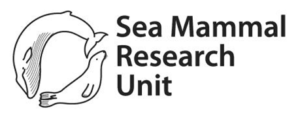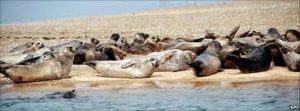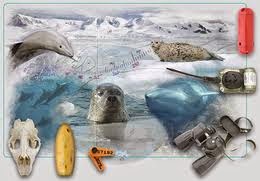Marine Mammal Conservation: from policy change to bycatch reduction
 The research undertaken from 1996 to 2013 by researchers of the Sea Mammal Research Unit (SMRU) of the School of Biology focused on the accurate measurement of marine mammal populations and distributions in UK and EU waters. As a result of evidence that the research provided to government:
The research undertaken from 1996 to 2013 by researchers of the Sea Mammal Research Unit (SMRU) of the School of Biology focused on the accurate measurement of marine mammal populations and distributions in UK and EU waters. As a result of evidence that the research provided to government:
- effective conservation of marine mammals has been put in place in UK, EU and international waters
- UK and EU policy objectives have been defined for marine mammal conservation
- UK obligations to EU legislation are being delivered
- marine mammal bycatch has been reduced by over 90% in key fisheries
Marine mammals spend most of their lives under water and are typically highly mobile and difficult to study. This has necessitated the development within SMRU of new data collection technologies and statistical analysis methodologies to ensure that estimates of population abundance and mortality rates are robust. New techniques include:
- “sparse data sampling” from boats or aircraft, to give robust estimates of marine mammal population density and distribution
- new telemetry technology which allow individual animals to be tagged and their behaviour and movements to be logged and recovered via satellite or mobile phone
In 2011, SMRU was awarded the Queen’s Anniversary Prize for excellence in applied research promoting best practice in the health and governance of the ocean environment.

Harbour seal decline
SMRU scientists have accurately quantified the decline in populations of harbour seals in UK waters in the period 2000-07 [research article: DOI: 10.1111/j.1469-7998.2007.00311.x], demonstrating that populations were dropping significantly in diverse locations from Shetland to the Wash, but were stable or increasing in the Hebrides. SMRU’s research has been instrumental in the development of policy on marine mammal conservation at an EU level, such as the Marine Strategy Framework Directive (MSFD) (2010) which, together with the EU Habitats Directive (1992), places legal obligations on Member States to assess and report on the conservation status of their marine mammal populations. The large majority of the information on cetacean distribution and abundance used by the UK to report under Article 17 of the Habitats Directive was generated by SMRU-led surveys. Other EU countries bordering the Atlantic Ocean have also made extensive use of this information.
Rogue seals in the Moray Firth
In the Moray Firth seals had been shot due to the perception that they that they impacted on salmon stocks, and thus the local economy. Research in the period 2005-08, using photo sampling of seals combined with analysis of their diets, suggested that only a small number of rogue seals specialising in river feeding were responsible. Research showed that targeting individual seals in rivers is a more effective management option [research article: DOI: 10.1111/j.1469-1795.2011.00469.x]. This resulted in the Moray Firth Seal Management Plan (MFSMP), which saw a dramatic reduction (~60%) in seal shooting in the area. This led to the development, successful drafting and progression to legislation of the Marine (Scotland) Act 2010, which introduced a new system for licensing the removal and disturbance of seals and for placing protective measures on seals when that is deemed necessary.
Quantifying and assessing the importance of marine mammal bycatch
 In 2006, a global analysis by SMRU scientists and collaborators highlighted the bycatch of marine mammals in fisheries as the main threat to their conservation status [research article: DOI: 10.1111/j.1523-1739.2006.00338.x]. Under the EU Habitats Directive, MSFD, Council regulation 812/2004, the UK is required to reduce marine mammal bycatch to levels that are sustainable. To address these obligations, SMRU has implemented an observer scheme on UK fishing boats to quantify bycatch. SMRU has identified and helped to implement specific acoustic deterrent devices (Pingers) that have been effective in reducing cetacean bycatch by over 90% from over 400 animals in 2004/5 to just a handful in 2010-12 in the pair-trawl bass fishery in the English Channel. SMRU research has also shown that acoustic deterrent devices, known as a ‘pingers’, deployed in the Cornish Offshore Gillnet fishery in the period 2009-12 can reduce porpoise bycatch by over 90%. Since July 2013, the UK Marine Management Organisation is enforcing the use of ‘pingers’ in certain areas.
In 2006, a global analysis by SMRU scientists and collaborators highlighted the bycatch of marine mammals in fisheries as the main threat to their conservation status [research article: DOI: 10.1111/j.1523-1739.2006.00338.x]. Under the EU Habitats Directive, MSFD, Council regulation 812/2004, the UK is required to reduce marine mammal bycatch to levels that are sustainable. To address these obligations, SMRU has implemented an observer scheme on UK fishing boats to quantify bycatch. SMRU has identified and helped to implement specific acoustic deterrent devices (Pingers) that have been effective in reducing cetacean bycatch by over 90% from over 400 animals in 2004/5 to just a handful in 2010-12 in the pair-trawl bass fishery in the English Channel. SMRU research has also shown that acoustic deterrent devices, known as a ‘pingers’, deployed in the Cornish Offshore Gillnet fishery in the period 2009-12 can reduce porpoise bycatch by over 90%. Since July 2013, the UK Marine Management Organisation is enforcing the use of ‘pingers’ in certain areas.
The Head of Science at the International Whaling Commission has said, “the work of SMRU on matters related to cetacean conservation and management has been of immeasurable value to our work and to cetacean conservation. The theoretical and practical developments that have arisen from SMRU scientists represent a remarkable degree of innovation from a single group. The impact on the conservation and management has been profound.”